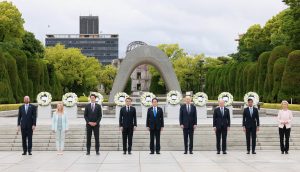The apex moment of Japan’s G-7 presidency was the summit in Hiroshima from May 19-21. It was a moment of personal triumph for Prime Minister Kishida Fumio, a Hiroshima native who felt it was deeply important for global leaders to talk to survivors of the world’s only wartime atomic bombings.
The Diplomat’s Shannon Tiezzi interviewed Yuki Tatsumi, a senior fellow and co-director of the East Asia Program and director of the Japan Program at the Stimson Center, about the outcomes of the G-7 summit, and how it fits into the big picture of Japanese diplomacy under Kishida.
From Japan’s perspective, what were the biggest achievements of the G-7 Summit in Hiroshima?
I think the fact that the summit took place in Hiroshima in the middle of Russia-Ukraine war (in which Russia has not been hesitant to use nuclear intimidation) was significant. For Prime Minister Kishida, it was a big political score to bring the summit to Hiroshima, and have some survivors of the nuclear blast meet with the other leaders.
The G-7 leaders issued a “Hiroshima Vision of Nuclear Disarmament,” which is an issue of deep personal significance for Prime Minister Kishida. How do you evaluate the substance of this vision, versus its symbolism?
The Hiroshima Vision has been panned by nuclear disarmament supporters for not having enough substance. However, I think it is an accomplishment on its own that G-7 leaders actually agreed on the statement on nuclear disarmament when there is a renewed look at these issues.
South Korean President Yoon Suk-yeol attended the Hiroshima Summit as a guest, marking his second trip to Japan in two months. How did the G-7 summit, and the U.S.-Japan-South Korea trilateral summit held on the sidelines, advance the Japan-South Korea relationship?
I think this was very meaningful way for Kishida to reciprocate Yoon’s visit to Tokyo. Especially when the two of them visited the memorial for ethnic Koreans that perished by the nuclear blast. That was a good proactive gesture on the part of Kishida.
Tokyo made a point of including developing countries in the G-7 summit, inviting the chairs of the African Union, Association of Southeast Asian Nations, and the Pacific Islands Forum. How did Japan fare in its attempt to bridge the gap between the Global South and the grouping of seven wealthy democracies?
Japan has always championed the cause of bridging the gap between the advanced industrialized countries and Global South. Japan has been a strong proponent for TICAD [the Tokyo International Conference on African Development], for example, and has a track record of attempting to offer an alternative to China’s cash flow into Africa by “quality development assistance.” I think it did fare fairly well.
Ukrainian President Zelenskyy’s in-person attendance at the summit was a last-minute surprise. What role does support for Ukraine play in Japan’s overall foreign policy, and how big of a priority is it?
Zelenskyy’s visit pretty much stole the thunder of the G-7. When his visit was announced, it was all about support Ukraine from that point on.
I think Japan’s strong support for Ukraine (and its shift in its policy toward Russia – basically sacrificing any potential advance in its talks over the Northern Territories) firmly anchored Japan with the United State and its European allies, giving Japan credentials as the supporter of universal norms and values.

































